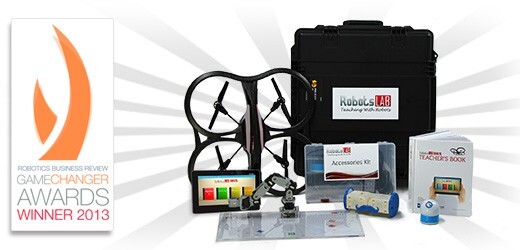NAO is the first robot that goes to Mars
On January 18, 2014, Aldebaran’s NAO Robot stood where no robot has gone before, and RobotsLAB was responsible for training his seven human companions in the finer points of his programming. NAO will be the only robot in an analog astronaut crew ascending into the Mars Society’s, Mars Desert Research Station in the the high desert of Utah. Anyone familiar with the high desert can appreciate the analogy--at this time of year the high desert is nearly as barren, dry, sandy and cold as the surface of Mars!

- 0 Comments
- Feb 5, 2014 11:58:00 PM
- Posted by Mike Nardine
- Topics: Robotics, NAO, 21st Century Classroom, International News, space,, Mars,
Oklahoma public schools are boosting their STEM learning with RobotsLAB BOX
Oklahoma public schools are about to receive an enormous boost to their STEM learning programs. The innovative Oklahoma City STEM learning facility techJoynT has teamed with us here at RobotsLAB in San Francisco to bring our award winning RobotsLAB BOX with its innovative math teaching aids to public school students in the state. Yes, the study of math is about to become exciting!
As those of you familiar with this blog are aware, our BOX is designed to assist math educators in teaching abstract math concepts by engaging students with robots. And as Dr Peter Stone, Alfred P. Sloan Research Fellow, Guggenheim Fellow, AAAI Fellow, Fulbright Scholar, and Professor in the Department of Computer Science at the University of Texas at Austin, explains “You don’t need to be experienced with robotics or have a degree in computer science, just an enthusiasm for your subject area...You can open the BOX, turn on the preloaded tablet and within minutes be explaining quadratic equations with a quad copter.” This beats pontificating in front of a blackboard every time!
- 0 Comments
- Jan 31, 2014 6:02:00 PM
- Posted by Charles Nimrad
- Topics: Math, About the BOX, Local News, EdTech, STEM, Education, 21st Century Classroom, School, Student Engagement
5 Tools Everyone In The Educational Robotics Industry Should Be Using
Of course the first answer to the question posited by the title of this piece is a facetious one--lots of money! So let us qualify the question a bit more by asking, "What are 5 tools everyone in the educational robotics industry should be using that most of us in the industry can afford?"
Since learning to code is so important to any STEM discipline, the first tool everyone in the educational robotics industry should be using is the online community and programming language called Scratch. This innovative site helps kids learn its namesake programming language and create interactive stories, games and computer animations. This outstanding tool is actually free!
Since math is basic to any scientific endeavor, the ability to interest and engage students in math is crucial to the educational robotics industry. Our second tool that everyone in the industry should be using, the RobotsLAB BOX, has proved its ability to interest and engage kids in math with an innovative combination of robots and tablets in many progressive school districts. The old teaching standbys like the book and the whiteboard can’t compete with "cool" robot helicopters demonstrating quadratic equations in real-time on a tablet.
- 0 Comments
- Jan 24, 2014 12:00:00 PM
- Posted by Elad Inbar
- Topics: Math, Robotics, Teaching with the RobotsLAB BOX, About the BOX, EdTech, STEM, Education, Computer Science, NAO, code, 21st Century Classroom, School, Student Engagement, Middle School
How To Solve The Biggest Problem With STEM Education
Judging from the number of e-gadget users in this country, technology is all the rage. Over 90% of adults have a cell phone. Thirty-four percent (34%) own a tablet. And no one doubts that the percentages will continue to rise. One might also be forgiven for thinking our schools are up to the job of graduating the vast numbers of science, technology, engineering and math students needed to keep this country in the forefront of this technology wave--the interest is obviously there. Unfortunately that is not the case!
By 2018--now less than 4 years and a single generation of high school students away--we are expecting at least 8 million jobs in the US dependent on skills learned in STEM learning courses. But experts estimate that less than five million of those jobs will go to kids from American schools, with three million or more of these well-paid positions going to foreign applicants.
Why is this happening? Why can’t our schools keep up with the demand for young people trained in science, technology, engineering and math? Well as you might expect there are all sorts of excuses for this, from lack of funding to a lack of interest in STEM learning on the part of students themselves. We at RobotsLAB can’t do much about the funding issue; that requires political action. What we can do is help change the culture of math education.
- 0 Comments
- Jan 23, 2014 10:00:00 AM
- Posted by Mike Nardine
- Topics: Math, Teaching with the RobotsLAB BOX, About the BOX, EdTech, STEM, Education, 21st Century Classroom, Student Engagement, Middle School
Here’s why we absolutely need EdTech
Here’s a question for you: What is your opinion as to the importance of EdTech in education? EdTech, as you know, is short for educational technology.
What defines EdTech, you ask?
Good question! You see the term everywhere but no definitions. So let’s go with the definition advanced by our good friends at Wikipedia: "Educational technology, sometimes termed EdTech, is the study and ethical practice of facilitating e-learning, which is the learning and improving performance by creating, using and managing appropriate technological processes and resources…" "Appropriate technological processes and resources" include more than just the Internet, although online courses are important tools; tablets, computers, cell phones, the whole digital zoo is included. Even robots! Especially robots!

- 0 Comments
- Dec 30, 2013 4:30:00 PM
- Posted by Charles Nimrad
- Topics: EdTech, STEM, Education, 21st Century Classroom, School, Student Engagement, Middle School
Augmented Reality practice in math classroom?
What the heck is “augmented reality?” That was my first thought when first seeing the phrase in a related post. No, I take that back; to tell the truth, like most people I asked, I thought it was merely another way to say “virtual reality.” But It most certainly isn't...
This according to the Wikipedia: Augmented reality (AR) is a live, direct or indirect, view of a physical, real-world environment whose elements are augmented (or supplemented) by computer-generated sensory input such as sound, video, graphics or GPS data. By contrast, virtual reality replaces the real world with a simulated one.”
Let’s put it another way: augmented reality is to The Minority Report with Tom Cruise as virtual reality is to Inception with Leonardo Dicaprio. Remember in The Minority Report when Tom Cruise stood facing a huge transparent computer screen manipulating images and data with gloved hands? That manipulation, a combination of real objects (gloved hands) and digital reality (data and images), makes for a perfect example of augmented reality (a teacher holding the control tablet from the RobotsLAB BOX in his hand can impose data on the real world the way Tom Cruise did--and he wouldn’t have to wear gloves!) On the other hand, Leonardo DiCaprio's avatar immersed in a simulated dreamworld, is a perfect example of virtual reality.

- 0 Comments
- Nov 25, 2013 11:29:51 PM
- Posted by Mike Nardine
- Topics: Math, About the BOX, EdTech, 21st Century Classroom, algebra,
How to improve Math proficiency in 21st century classroom
Once upon a time...and not all that long ago, teachers found motivating youngsters to engage themselves in the wonders of mathematics a difficult proposition--which is not to say that educators here in the 21st Century have completely overcome all the difficulties. No, it still takes a committed teacher to break down the barriers both societal and unique to the child to get it done.
Prof. Alfred Posamentier, Dean and professor of mathematics education at Mercy College, NY suggests 9 strategies a teacher might use to engage students with mathematics:
- 0 Comments
- Nov 11, 2013 1:50:00 PM
- Posted by Mike Nardine
- Topics: Math, 21st Century Classroom, Student Engagement
Relevant Posts
Popular Posts
Subscribe to Email Updates
-
I Want To Learn MoreADDITIONAL INFORMATION



